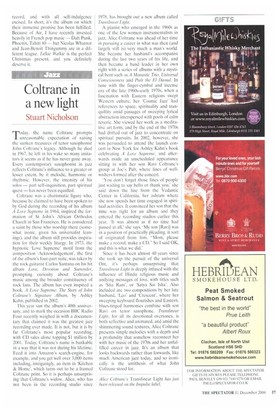Jazz
Coltrane in a new light
Stuart Nicholson
Today, the name Coltrane prompts unreasonable expectation of raising the sunken treasures of tenor saxophonist John Coltrane's legacy. Although he died in 1967, he left in his wake so many imitators it seems as if he has never gone away. Every contemporary saxophonist in jazz reflects Coltrane's influence to a greater or lesser extent, be it melodic, harmonic or rhythmic. However, the intensity of his solos — part self-inquisition, part spiritual quest — has never been equalled.
Coltrane was a charismatic figure who, because he claimed to have been spoken to by God during the recording of his album A Love Supreme in 1964, inspired the formation of St John's African Orthodox Church in San Francisco. lie is considered a saint by those who worship there (somewhat ironic, given his universalist leanings), and the album still provides inspiration for their weekly liturgy. In 1973, the hypnotic 'Love Supreme' motif from the composition 'Acknowledgement', the first of the album's four-part suite, was taken by the rock guitarist Carlos Santana on his hit album Love, Devotion and Surrender, prompting curiosity about Coltrane's music among the broader constituency of rock fans. The album has even inspired a book, A Love Supreme: The Sun), of John Coltrane's Signature Album, by Ashley Kahn, published in 2002.
This year saw the album's 40th anniversary, and to mark the occasion BBC Radio Four recently weighed in with a documentary that claimed it was the greatest jazz recording ever made. It is not, but it is by far Coltrane's most popular recording, with CD sales alone topping $1 million by 2001. Today, Coltrane's name is bankable in a way that it was not during his lifetime. Feed it into Amazon's search-engine, for example, and you get well over 3,000 items including, intriguingly, an item in 'Kitchen & Home', which turns out to be a framed Coltrane print. So it is perhaps unsurprising that Coltrane's widow, Alice, who has not been in the recording studio since 1978, has brought out a new album called Translinear Light.
A pianist who emerged in the 1960s as one of the few women instrumentalists in jazz, Alice Coltrane was ahead of her time in pursuing a career in what was then (and largely still is) very much a man's world. She became her husband's accompanist during the last two years of his life, and then became a band leader in her own right with a series of albums with a mystical bent such as A Monastic Trio, Universal Consciousness and Ptah the El Daoud. In tune with the finger-cymbal and incense era of the late 1960s–early 1970s, when a fascination with Eastern religions swept Western culture, her 'Cosmic Jazz had references to space, spirituality and tran quillity amid passages of sweeping lyrical abstraction interspersed with pools of calm reverie. She viewed her work as a medita tive art form, and by the end of the 1970s had drifted out of jazz to concentrate on spiritual pursuits. In 2002, however, she was persuaded to attend the launch con cert in New York for Ashley Kahn's book celebrating A Love Supreme, and after wards made an unscheduled appearance sitting in with her son Ravi Coltrane's group at Joe's Pub, where lines of wellwishers formed after the concert.
You don't forget those lines of people just waiting to say hello or thank you,' she said down the line from the Vedantic Center in California, her ashram where she now spends her time engaged in spiri tual activities. It convinced her son that the time was right for an album and they entered the recording studios earlier this year. It was almost as if no time had passed at all,' she says. 'My son [Ravi] was in a position of practically pleading, it sort of originated from him, "Mom, please make a record, make a CD." So I said OK, and this is what we did.'
Since it has been almost 40 years since she took up the pursuit of the universal Om, it's perhaps unsurprising that Translinear Light is deeply infused with the influence of Hindu religious music and unifying messages of love, with titles such as Sita Rani', or Satya Sai Isha'. Also included are two compositions by her late husband, 'Leo' and 'Crescent', where her
sweeping keyboard flourishes and Eastern, blues-tinged harmonies combine with Son
Ravi on tenor saxophone. Translinear Light, for all its devotional overtones, is both reflective and animated, and amid the shimmering sound textures, Alice Coltrane presents simple melodies with a depth and a profundity that somehow reconnect her with her music of the 1970s and her unful filled career in jazz. It's an album that looks backwards rather than forwards, like much American jazz today, and so ironically is the antithesis of what John Coltrane stood for.
Alice Coltrane's Translinear Light has just been released on the Impulse label.










































































 Previous page
Previous page